Confused by LED floodlight options? Picking the wrong one risks safety and performance. Key certifications like UL, CE, and DLC are your guide to quality and reliability.
For LED floodlights, prioritize UL certification for safety in North America, CE for European market access, and DLC for energy efficiency rebates in the U.S. and Canada. These marks ensure the product has been tested against rigorous safety, performance, and quality standards, protecting your investment.
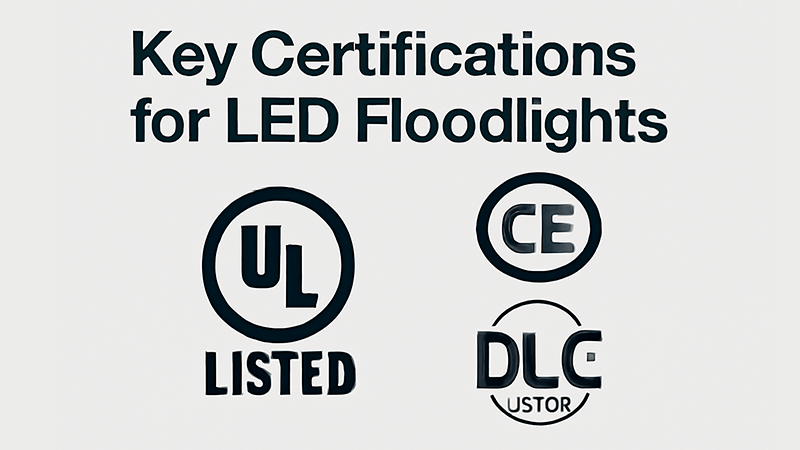
These acronyms—UL, CE, DLC—can seem confusing. But they are more than just letters on a box. They represent a promise of quality and safety. I’ve spent my career navigating these standards. Now, I want to break them down for you. Let’s explore what each one really means for your projects, so you can make informed decisions with confidence and avoid common pitfalls.
What are the certifications for LED lighting?
Drowning in certification acronyms? Ignoring them can lead to unsafe or non-compliant products. Understanding the key standards helps you quickly identify quality lighting for your market.
Major LED lighting certifications include UL for safety (North America), CE for European conformity, and RoHS for hazardous substances. Others like DLC focus on energy efficiency, while ENEC provides European safety marks. Each serves a specific purpose, verifying different aspects of a light’s quality and compliance.
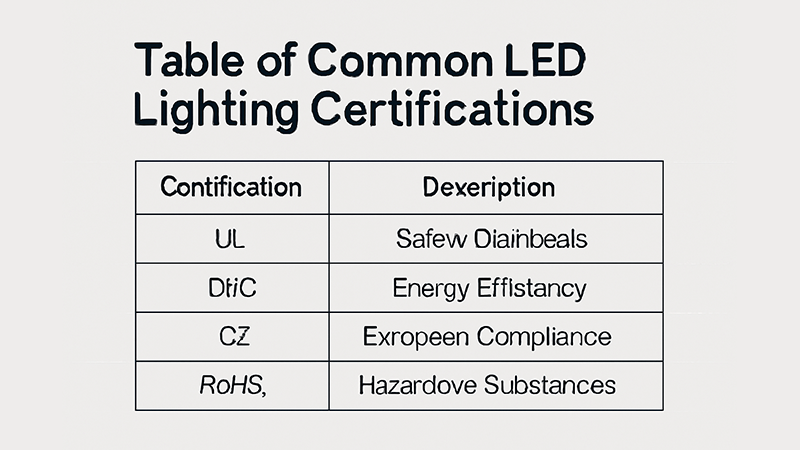
Regional and Purpose-Specific Standards
Certifications are not a one-size-fits-all matter. Different markets have strict, non-negotiable legal requirements. As a purchasing manager, your first question should always be, "Where will this product be installed?" This determines which mandatory certifications you need. For example, a product destined for Germany needs a CE mark, while the same product going to Chicago needs a UL mark. I’ve built a quick reference table to help you keep them straight. It’s the kind of chart I wish I had when I started.
| Certification |
Region |
Primary Focus |
Is it Mandatory? |
| UL |
North America |
Safety (Fire & Electrical Shock) |
De Facto Mandatory |
| CE |
European Union |
Safety, Health, Environment |
Mandatory for EU Market |
| DLC |
North America |
Energy Efficiency & Performance |
Voluntary (for rebates) |
| FCC |
United States |
Electromagnetic Interference |
Mandatory for Electronics |
| RoHS |
EU (Globally adopted) |
Restriction of Hazardous Substances |
Mandatory for EU Market |
The Danger of Fraudulent Certifications
The most dangerous pitfall is not a lack of certification but a fake one. Some suppliers will place a CE or UL logo on their product without ever having it tested. They might even create a fake certificate document. This is outright fraud. I remember an early project with a partner in the UAE, a sourcing manager just like Shaz. He purchased a container of floodlights that supposedly had all the right European certifications. When the shipment arrived, customs officials discovered the certificates were forged. The entire shipment was impounded. His project was delayed by months, and the financial loss was huge. That’s why you must always verify. Ask for the certificate number and check it on the official database of the issuing body (like UL’s public directory). A reputable manufacturer will never hesitate to provide this proof. If they delay or make excuses, walk away.
Do LED lights need to be UL certified?
Is the UL logo just a nice-to-have? In North America, skipping it can cause failed inspections and serious liability. Prioritizing UL certification is essential for market compliance.
In the United States and Canada, UL certification is not legally mandatory at the federal level, but it is a de facto requirement. Electrical inspectors, insurance companies, and retailers all require it to ensure products meet safety standards. Selling non-UL listed products is a significant business risk.
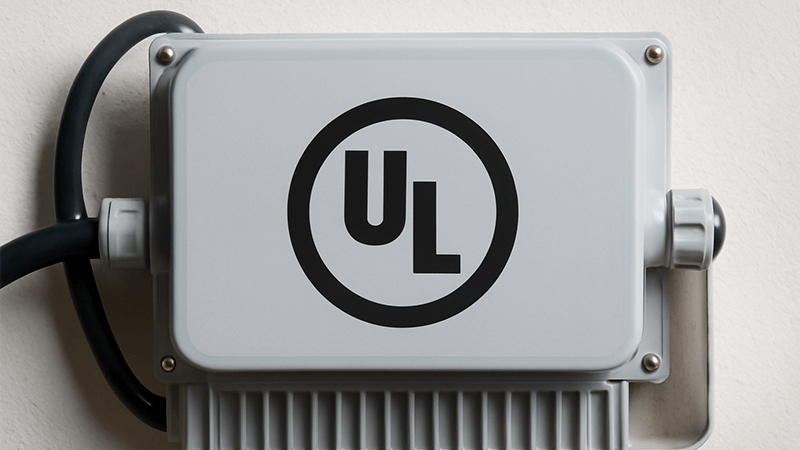
UL Listed vs. UL Recognized: A Critical Distinction
Here is a detail that trips up many buyers. You will see suppliers advertise products with "UL Recognized components." This is not the same as a "UL Listed" product.
- UL Recognized: This mark applies to individual components that are part of a larger product, like an LED driver or a power cord. It means that specific part is safe, but it does not mean the final, assembled floodlight is.
- UL Listed: This mark applies to the entire, standalone product. It certifies that the complete floodlight, as a system, has been tested for safety.
For a finished product like an LED floodlight, you must look for the UL Listed mark. I’ve seen manufacturers try to mislead buyers by highlighting that their driver is UL Recognized, hoping the buyer won’t notice that the complete luminaire is not UL Listed. An electrical inspector will not approve a fixture just because some of its parts are certified.
The Real-World Cost of Non-UL Products
The financial risk of using non-UL products in North America is massive. I worked with a contractor in Florida who was installing lighting for a new strip mall. He chose non-UL floodlights to lower his bid and win the job. The installation was completed, but the city inspector immediately red-tagged the entire project during the final inspection. The contractor had to remove all the uncertified fixtures, purchase new UL Listed ones, and pay his crew to do the entire installation again. The delay also resulted in penalties from the property developer. The money he thought he "saved" was lost many times over. This is a story I tell all my partners. For projects in the U.S. and Canada, UL is not a feature; it’s the price of admission. It guarantees safety, insurability, and peace of mind.
What is UL certification for lighting?
You see the UL mark, but what does it truly mean for a light fixture? Without knowing, you might fall for fake labels. Understanding the process empowers you.
UL certification for lighting is an independent, third-party verification that a product meets specific safety standards. Underwriters Laboratories (UL) tests for risks of fire, electric shock, and other hazards. It ensures the product is constructed safely, from its wiring and housing to its heat management.
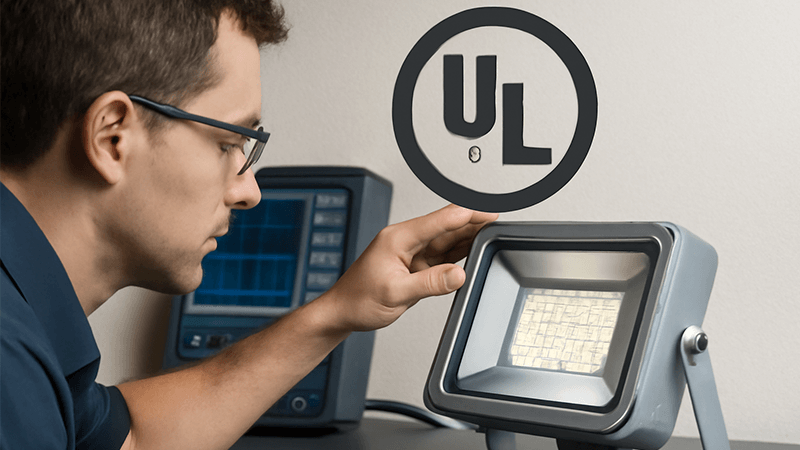
The Rigorous Testing Process
Getting a product UL Listed is an expensive and time-consuming process for a manufacturer. It’s a serious commitment. UL engineers don’t just look at a spec sheet; they try to make the product fail in a controlled lab environment to ensure it fails safely in the real world. Key tests for an LED floodlight include:
- Thermal Testing: The floodlight is operated at maximum power in a hot environment to ensure its components, especially the casing, do not exceed safe temperature limits. This prevents fire hazards and burn risks.
- Water Ingress Testing: For outdoor fixtures, UL performs high-pressure water spray tests (similar to IP rating tests) to confirm that water cannot enter the housing and cause a short circuit.
- Strain Relief and Mechanical Tests: They pull on cords and abuse the housing to ensure it can withstand normal installation stress and environmental factors without exposing live wires.
- Material Flammability: All plastic components are tested to ensure they are self-extinguishing and won’t contribute to the spread of a fire.
How UL Testing Prevents Performance Issues
While UL is primarily a safety standard, its tough requirements often filter out low-quality products. For example, one of the biggest problems in budget floodlights is the use of cheap, uncertified LED chips. These chips are not only inefficient but also generate excessive heat. A manufacturer using these poor components would likely fail UL’s thermal tests. The fixture would overheat, making it impossible to certify. Therefore, when you see a UL mark, you know the manufacturer has invested in quality thermal management and, by extension, likely uses more stable and reliable components. It’s an indirect guarantee of better construction. A product that can pass UL’s strict safety gauntlet is one that has been engineered properly from the ground up, reducing the risk of premature failure.
Do LED lights need FCC certification?
Ever experienced radio static near a new LED light? This interference can disrupt more than just music. FCC certification guarantees your lighting won’t cause these frustrating electronic issues.
Yes. Any electronic device in the U.S. that oscillates above 9 kHz, including the drivers in LED lights, must be FCC certified. This certification ensures the light does not emit electromagnetic interference that could disrupt radio, television, and other communication signals. It is a legal requirement.
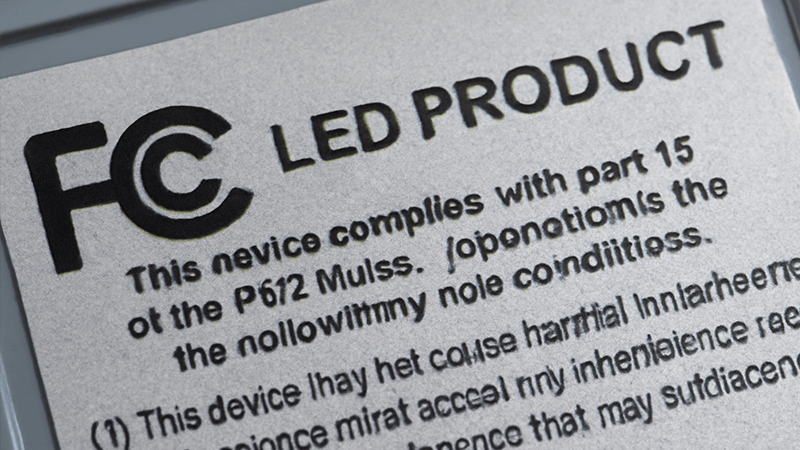
Understanding Electromagnetic Interference (EMI)
At its core, an LED driver is a sophisticated power supply that "switches" electricity on and off thousands of times per second to provide the LED chips with the correct power. This rapid switching creates a side effect: high-frequency electronic noise, also known as Electromagnetic Interference (EMI). Without proper design, this noise radiates outward from the fixture like a tiny, unlicensed radio station. This can cause static on AM/FM radios, interfere with Wi-Fi signals, or even disrupt sensitive equipment in commercial or industrial settings. The Federal Communications Commission (FCC) sets legal limits on how much EMI an electronic device can produce.
The Dangers of Ineffective Shielding
This is an area where I see many low-quality manufacturers cut costs. A well-designed LED driver includes internal filtering and shielding components—like inductors and capacitors—specifically to suppress this EMI. These components add cost. A cheap, non-compliant driver may look identical from the outside but will be missing this critical internal hardware. I once had a supplier show me two drivers side-by-side. The one that was not FCC compliant was missing about a dollar’s worth of components. That small saving could create huge problems. Imagine a floodlight installed at a warehouse that interferes with the handheld scanners used for inventory management. Or lights at a gas station that create noise on the security communication system. This is why FCC compliance is not just about following a rule; it’s about ensuring your product is a good electronic citizen and won’t negatively impact other critical systems. You must always confirm that the product meets FCC Part 15 standards, which is the specific rule governing this type of device.
Conclusion
In short, certifications like UL, CE, and FCC are not just paperwork. They are your essential tools for ensuring safety, performance, and legal compliance in your lighting projects.